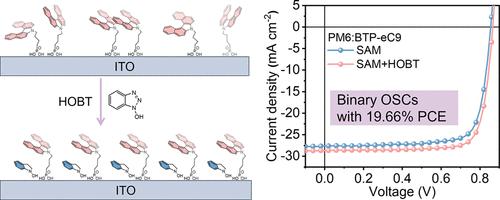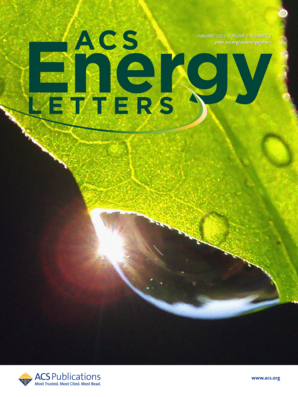Binary Organic Solar Cells with >19.6% Efficiency: The Significance of Self-Assembled Monolayer Modification
IF 19.3
1区 材料科学
Q1 CHEMISTRY, PHYSICAL
引用次数: 0
Abstract
Improving the uniformity and density of self-assembled monolayers (SAMs) is crucial to elevate the photovoltaic performance of organic solar cells (OSCs). Herein, we introduced the small molecules 1-hydroxybenzotriazole (HOBT) to modulate the distribution and electrical properties of (4-(7H-dibenzo[c,g]carbazol-7-yl)butyl)phosphonic acid (4PADCB) on indium tin oxide (ITO) transparent electrodes in an innovative manner. The hydroxyl group of HOBT interacts with the phosphate group of SAMs, while the steric repulsion exerted by the HOBT backbone efficiently regulates the distribution of SAMs. This led to a more uniform and dense distribution of SAMs on ITO. Furthermore, HOBT-modified SAMs have improved the crystallization and vertical phase separation of the upper active layer. Consequently, the PM6:BTP-eC9 binary OSCs based on HOBT-modified SAMs exhibit an impressive PCE of 19.66%. Our work presents an effective strategy for regulating the SAM morphology and offers a promising approach for advancing OSCs.

效率大于 19.6% 的二元有机太阳能电池:自组装单层修饰的意义
改善自组装单层(SAM)的均匀性和密度对于提高有机太阳能电池(OSC)的光电性能至关重要。在此,我们引入了小分子 1-hydroxybenzotriazole (HOBT),以创新的方式调节 (4-(7H-二苯并[c,g]咔唑-7-基)丁基)膦酸 (4PADCB) 在铟锡氧化物 (ITO) 透明电极上的分布和电性能。HOBT 的羟基与 SAM 的磷酸基相互作用,而 HOBT 主干产生的立体斥力则有效地调节了 SAM 的分布。这使得 SAM 在 ITO 上的分布更加均匀和致密。此外,HOBT 修饰的 SAM 改善了上活性层的结晶和垂直相分离。因此,基于 HOBT 改性 SAM 的 PM6:BTP-eC9 二元 OSC 显示出令人印象深刻的 19.66% PCE。我们的工作提出了一种调节 SAM 形态的有效策略,为推进 OSCs 的发展提供了一种前景广阔的方法。
本文章由计算机程序翻译,如有差异,请以英文原文为准。
求助全文
约1分钟内获得全文
求助全文
来源期刊

ACS Energy Letters
Energy-Renewable Energy, Sustainability and the Environment
CiteScore
31.20
自引率
5.00%
发文量
469
审稿时长
1 months
期刊介绍:
ACS Energy Letters is a monthly journal that publishes papers reporting new scientific advances in energy research. The journal focuses on topics that are of interest to scientists working in the fundamental and applied sciences. Rapid publication is a central criterion for acceptance, and the journal is known for its quick publication times, with an average of 4-6 weeks from submission to web publication in As Soon As Publishable format.
ACS Energy Letters is ranked as the number one journal in the Web of Science Electrochemistry category. It also ranks within the top 10 journals for Physical Chemistry, Energy & Fuels, and Nanoscience & Nanotechnology.
The journal offers several types of articles, including Letters, Energy Express, Perspectives, Reviews, Editorials, Viewpoints and Energy Focus. Additionally, authors have the option to submit videos that summarize or support the information presented in a Perspective or Review article, which can be highlighted on the journal's website. ACS Energy Letters is abstracted and indexed in Chemical Abstracts Service/SciFinder, EBSCO-summon, PubMed, Web of Science, Scopus and Portico.
 求助内容:
求助内容: 应助结果提醒方式:
应助结果提醒方式:


